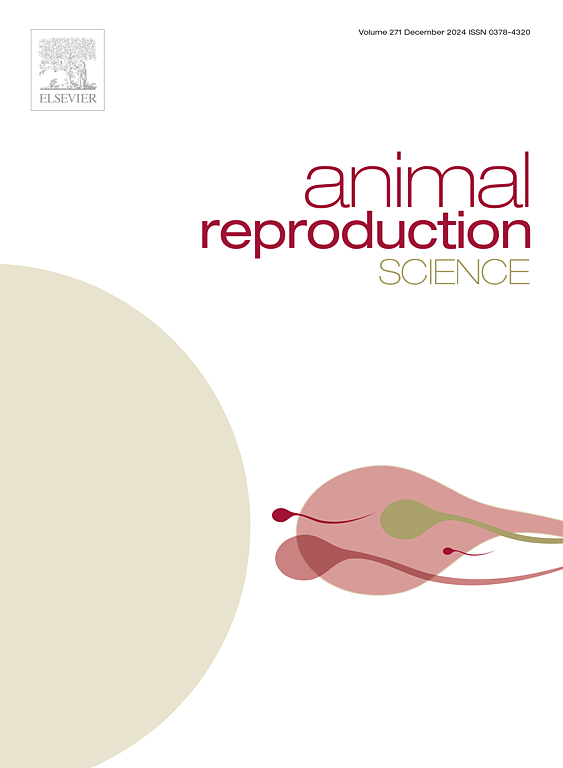New approaches in bovine spermatozoa evaluation and their relationship with male fertility
IF 2.2
2区 农林科学
Q1 AGRICULTURE, DAIRY & ANIMAL SCIENCE
引用次数: 0
Abstract
Male fertility potential depends on physical, endocrine, and genetic factors responsible for producing functional male gametes. Although the main function of the male gamete, the spermatozoon, is to deliver its genetic material to the oocyte, this premise has been modified over the past few years. It is believed that the spermatozoon provides essential factors for fertilization and pre-implantation embryo development. A viable/healthy spermatozoon has functional subcellular compartments (nucleus, acrosome, midpiece, and flagellum) due to the actions of proteins, transcripts, and epigenetic marks in the organelles present in them that have important roles in reproductive biology. Male fertility potential reflects viable spermatozoa with proper function. Therefore, new approaches to functional sperm analysis are essential. Additionally, intrinsic factors and sperm molecules constitute potential biomarkers of viable spermatozoa and male fertility. Among these factors are proteins, the genome, and coding and non-coding RNAs, such as microRNAs, that act during fertilization and early embryo development. Research has been seeking increasingly efficient tools to predict fertility and functional studies of these molecules through gene and protein expression. Thus, analytical tools are essential to identify and classify viable and functional spermatozoa, to evaluate assisted reproductive male potential.
牛精子评价及其与雄性生育能力关系的新途径
男性的生育潜力取决于生理、内分泌和遗传因素,这些因素负责产生功能性的雄性配子。尽管雄性配子(精子)的主要功能是将其遗传物质传递给卵母细胞,但在过去几年中,这一前提已经被修改。精子被认为是受精和着床前胚胎发育的重要因素。存活/健康的精子具有功能性的亚细胞区室(细胞核、顶体、中间和鞭毛),这是由于其中存在的细胞器中的蛋白质、转录物和表观遗传标记的作用,这些细胞器在生殖生物学中起着重要作用。男性生育潜力反映了具有正常功能的活精子。因此,功能精子分析的新方法是必不可少的。此外,内在因素和精子分子构成了活精子和男性生育能力的潜在生物标志物。这些因素包括蛋白质、基因组、编码和非编码rna,如microrna,它们在受精和早期胚胎发育过程中起作用。研究人员一直在寻找越来越有效的工具,通过基因和蛋白质表达来预测这些分子的生育能力和功能研究。因此,分析工具是必要的,以识别和分类活的和功能精子,以评估辅助生殖男性的潜力。
本文章由计算机程序翻译,如有差异,请以英文原文为准。
求助全文
约1分钟内获得全文
求助全文
来源期刊

Animal Reproduction Science
农林科学-奶制品与动物科学
CiteScore
4.50
自引率
9.10%
发文量
136
审稿时长
54 days
期刊介绍:
Animal Reproduction Science publishes results from studies relating to reproduction and fertility in animals. This includes both fundamental research and applied studies, including management practices that increase our understanding of the biology and manipulation of reproduction. Manuscripts should go into depth in the mechanisms involved in the research reported, rather than a give a mere description of findings. The focus is on animals that are useful to humans including food- and fibre-producing; companion/recreational; captive; and endangered species including zoo animals, but excluding laboratory animals unless the results of the study provide new information that impacts the basic understanding of the biology or manipulation of reproduction.
The journal''s scope includes the study of reproductive physiology and endocrinology, reproductive cycles, natural and artificial control of reproduction, preservation and use of gametes and embryos, pregnancy and parturition, infertility and sterility, diagnostic and therapeutic techniques.
The Editorial Board of Animal Reproduction Science has decided not to publish papers in which there is an exclusive examination of the in vitro development of oocytes and embryos; however, there will be consideration of papers that include in vitro studies where the source of the oocytes and/or development of the embryos beyond the blastocyst stage is part of the experimental design.
 求助内容:
求助内容: 应助结果提醒方式:
应助结果提醒方式:


